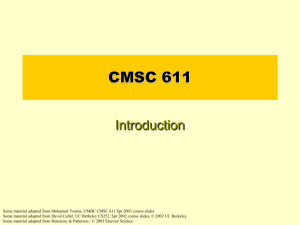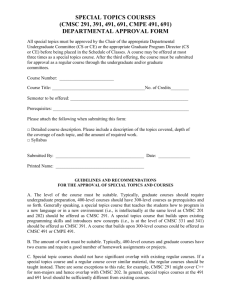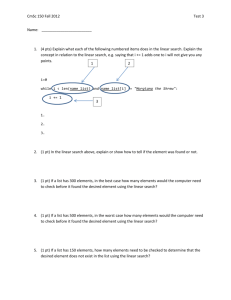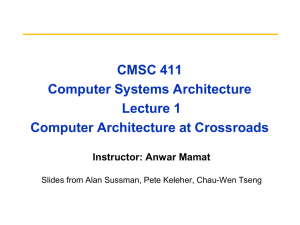Slide 9 - functions
advertisement
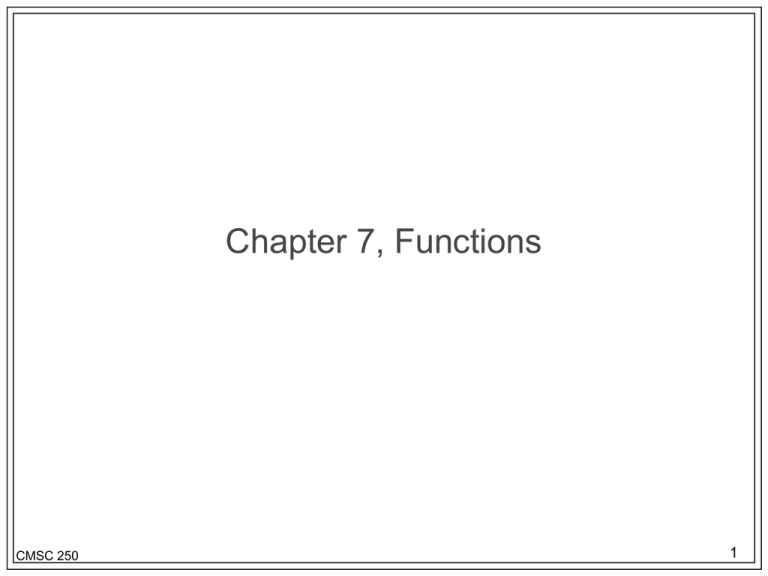
Chapter 7, Functions
CMSC 250
1
Function terminology
A relationship between elements of two sets such that no
element of the first set is related to more than one
element of the second set
Domain: the set which contains the values to which the
function is applied
Codomain: the set which contains the possible values
(results) of the function
Range (or image): the set of actual values produced
when applying the function to the values of the domain
CMSC 250
2
More function terminology
f: X Y
–
–
–
–
–
f
is the function name
X
is the domain
Y
is the co-domain
xX yY
f sends x to y
f(x) = y f of x; the value of f at x ; the image of x under f
A total function is a relationship between elements of the
domain and elements of the co-domain where each and
every element of the domain relates to one and only one
value in the co-domain
A partial function does not need to map every element of
the domain
CMSC 250
3
Formal definitions
The range of f is {y Y | (x X)[f(x) = y]}
–where X is the domain and Y is the co-domain
The inverse image of y Y is
{x X | f(x) = y}
–the set of things in the domain X that map to y
Arrow diagrams
Determining if something is a function using an arrow diagram
Equality of functions
( functions f,g with the same domain X and codomain Y)
[f = g iff (x X)[f(x) = g(x)] ]
CMSC 250
4
Discrete Structures
CMSC 250
Lecture 38
April 30, 2008
CMSC 250
5
Types of functions
F:X Y is a one-to-one (or injective) function iff
(x1,x2 X)[F(x1) = F(x2) x1 = x2], or alternatively
(x1,x2 X)[x1 x2 F(x1) F(x2)]
F: X Y is not a one-to-one function iff
(x1,x2 X)[(F(x1) = F(x2)) ^ (x1 x2)]
F: X Y is an onto (or surjective) function iff
(y Y)(x X)[F(x) = y]
F: X Y is not an onto function iff
(y Y)(x X)[F(x) y]
CMSC 250
6
Proving functions one-to-one and onto
f: R R
f(x) = 3x 4
Prove or give a counterexample that f is one-to-one
– recall the definition (one of two definitions) of one-to-one is
(x1 , x2 R) [ f ( x1) f ( x2 ) x1 x2 ]
Prove or give a counterexample that f is onto
– recall the definition of onto is
(y R) (x R) [ f ( x) y ]
CMSC 250
7
One-to-one correspondence or bijection
F: X Y is bijective iff F: X Y is one-to-one and onto
If F: X Y is bijective then it has an inverse function
1
(F ) [Y X ]
1
(x X ) [ F ( x) y F ( y ) x]
1
(y Y ) [ F ( y ) x F ( x) y ]
CMSC 250
8
Proving something is a bijection
F: Q Q
–
–
–
–
CMSC 250
F(x) = 5x + 1/2
prove it is one-to-one
prove it is onto
then it is a bijection
so it has an inverse function
• find F1
9
The pigeonhole principle
Basic form:
A function from one finite set to a smaller finite set cannot be
one-to-one; there must be at least two elements in the domain
that have the same image in the codomain.
CMSC 250
10
Examples
Using this class as the domain:
– must two people share a birth month?
– must two people share a birthday?
Let A = {1,2,3,4,5,6,7,8}
– if I select 5 different integers at random from this set, must two
of the numbers sum exactly to 9?
– if I select 4 integers?
There exist two people in New York City who have the
same number of hairs on their heads.
There exist two subsets of {1,…,10} with three elements
which sum to the same value.
CMSC 250
11
Discrete Structures
CMSC 250
Lecture 39
May 2, 2008
CMSC 250
12
Another (more useful) form of the
pigeonhole principle
The generalized pigeonhole principle:
– For any function f from a finite set X to a finite set Y and for any
positive integer k, if n(X) > k * n(Y), then there is some y Y such
that y is the image of at least k+1 distinct elements of X.
Contrapositive form:
– For any function f from a finite set X to a finite set Y and for any
positive integer k, if for each y Y, f–1(y) has at most k elements,
then X has at most k n(y) elements.
CMSC 250
13
Examples
Using the generalized form:
– assume 50 people in the room, how many must share the same birth
month?
– n(A)=5 n(B)=3 F: P (A) P (B)
how many elements of P (A) must map to a single element of P (B)?
CMSC 250
14
Composition of functions
f: X Y1 and g: Y Z
– g ○ f: X Z
where Y1 Y
where (x X)[g(f(x)) = g ○ f(x)]
g(f(x))
x
z
y
f(x)
g(y)
Y1
X
CMSC 250
Y
Z
15
Composition on finite sets- example
Example
X = {1,2,3}, Y1 = {a,b,c,d}, Y = {a,b,c,d,e}, Z = {x,y,z}
f(1) = c
g(a) = y
g○f(1) = g(f(1)) = z
f(2) = b
g(b) = y
g○f(2) = g(f(2)) = y
f(3) = a
g(c) = z
g○f(3) = g(f(3)) = y
g(d) = x
g(e) = x
CMSC 250
16
Composition for infinite sets- example
f: Z Z f(n) = n + 1
g: Z Z g(n) = n2
g ○ f(n) = g(f(n)) = g(n+1) = (n+1)2
f ○ g(n) = f(g(n)) = f(n2) = n2 + 1
Note: g ○ f f ○ g
CMSC 250
17
Identity function
iX
the identity function for the domain X
iX : X X
iY
the identity function for the domain Y
iY : Y Y
CMSC 250
(xX) [iX(x) = x]
(yY) [iY(y) = y]
composition with the identity functions
18
Composition with inverse
Recall: if f is a bijection then f1 exists.
Let f: X Y be a bijection.
What is f ○ f1?
What is f1 ○ f?
CMSC 250
19
One-to-one in composition
If f: X Y and g: Y Z are both one-to-one, then
g ○ f: X Z is one-to-one.
If f: X Y and g: Y Z are both onto, then g ○ f: X Z
is onto.
CMSC 250
20
Cardinality
Comparing the “sizes” of sets:
– finite sets ( or there is a positive integer n such that there is a
bijective function from the set to {1,2,…,n})
– infinite sets (there is no such n such that there is a bijective
function from the set to {1,2,…,n})
sets A,B, A and B have the same cardinality iff there is
a one-to-one correspondence from A to B
In other words,
Cardinality(A) = Cardinality(B)
( a function f ) [f: A B f is a bijection]
CMSC 250
21
Countable sets
A set S is called countably infinite iff Cardinalit(S) =
Cardinality(Z+).
A set is called countable iff it is finite or countably
infinite.
A set which is not countable is called uncountable.
CMSC 250
22
Discrete Structures
CMSC 250
Lecture 40
May 5, 2008
CMSC 250
23
Countability of sets of integers and the
rationals
N
is this a countably infinite set?
Z
is this countably infinite set?
Neven is this a countably infinite set?
Card(Q+) =?= Card(Z)
CMSC 250
24
Real numbers
We’ll take just a part of this infinite set
Reals between 0 and 1 (noninclusive)
X = {x R | 0 < x < 1}
All elements of X can be written as
0.a1a2a3… an…
CMSC 250
25
Cantor’s proof
Assume the set X = {x R | 0 < x < 1} is countable
Then the elements in the set can be listed
0.a11a12a13a14…a1n…
0.a21a22a23a24…a2n…
0.a31a32a33a34…a3n…
… ………
Select the digits on the diagonal
Build a number d, such that d differs in its nth position
from the nth number in the list
1 if ann 1
dn
2 if ann 1
CMSC 250
26
All reals
Cardinality({x R | 0 < x < 1}) = Cardinality(R)
CMSC 250
27
